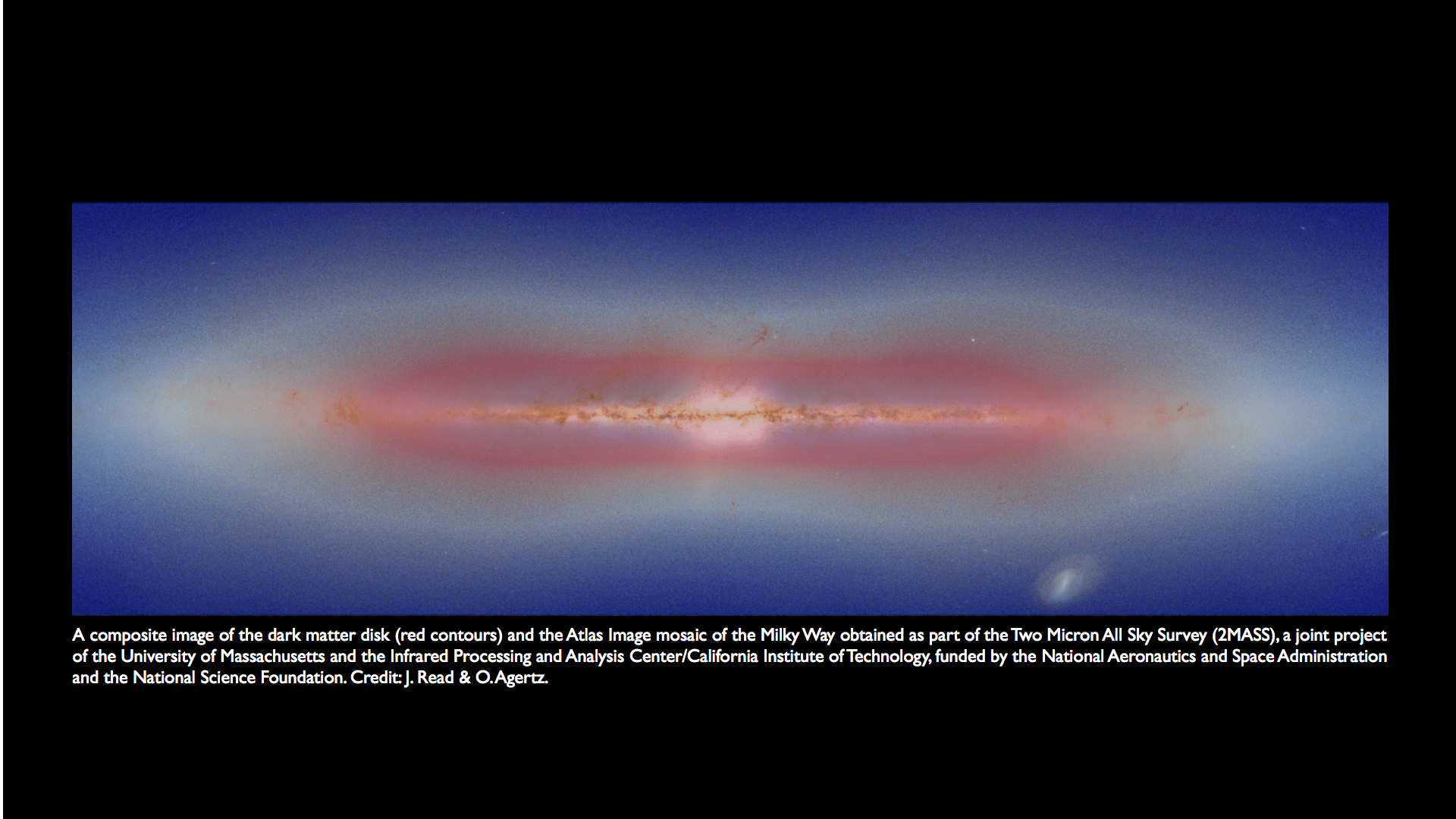[/caption]
Scientists are trying to understand the invisible and hypothetical ‘dark matter’ – the stuff that we know exists by inference of its gravitational influence on the matter we can see. The most common held notion of dark matter is that it exists in ‘halos’ or clumps that surround galaxies. But a new study predicts that galaxies like our own Milky Way, also contain a disk of dark matter. Using the results of a supercomputer simulation, scientists from the University of Zurich and the University of Central Lancashire say that if dark matter in fact resides as a disk within a galaxy, it could allow physicists to directly detect and identify the nature of dark matter for the first time.
Physicists believe dark matter makes up 22% of the mass of the Universe (compared with the 4% of normal matter and 74% comprising the mysterious ‘dark energy’). But, despite its pervasive influence, no-one is sure what dark matter consists of.
This ‘standard’ theory of dark matter is based on supercomputer simulations that model the gravitational influence of the dark matter alone. The new work includes the gravitational influence of the stars and gas that also make up our Galaxy.
Stars and gas are thought to have settled into disks very early on in the life of the Universe and this affected how smaller dark matter halos formed. The team’s results suggest that most lumps of dark matter in our locality merged to form a halo around the Milky Way. But the largest lumps were preferentially dragged towards the galactic disk and were then torn apart, creating a disk of dark matter within our Galaxy.
“The dark disk only has about half of the density of the dark matter halo, which is why no one has spotted it before,†said lead author Justin Read. “However, despite its low density, if the disk exists it has dramatic implications for the detection of dark matter here on Earth.â€
The Earth and Sun move at some 220 kilometres per second along a nearly circular orbit about the center of our Galaxy. Since the dark matter halo does not rotate, from an Earth-based perspective it feels as if we have a ‘wind’ of dark matter flowing towards us at great speed. By contrast, the ‘wind’ from the dark disk is much slower than from the halo because the disk co-rotates with the Earth.
“It’s like sitting in your car on the highway moving at a hundred kilometres an hourâ€, said team member Dr. Victor Debattista. “It feels like all of the other cars are stationary because they are moving at the same speed.â€
This abundance of low-speed dark matter particles, the science team says, could be a real boon for researchers because they are more likely to excite a response in dark matter detectors than fast-moving particles. “Current detectors cannot distinguish these slow moving particles from other background ‘noise’,†said Prof. Laura Baudis, a collaborator at the University of Zurich and one of the lead investigators for the XENON direct detection experiment, which is located at the Gran Sasso Underground Laboratory in Italy. “But the XENON100 detector that we are turning on right now is much more sensitive. For many popular dark matter particle candidates, it will be able to see something if it’s there.â€
If so, its possible that the dark disk could be directly detected in the very near future.


Stupid question (i’m no physicist) :
“Physicists believe dark matter makes up 22% of the mass of the Universe (compared with the 4% of normal matter and 74% comprising the mysterious ‘dark energy’). But, despite its pervasive influence, no-one is sure what dark matter consists of.”
Since when energy has mass? Energy in matter form has mass but energy itself isnt mass right?
Basically those physicists are saying that current theories only apply to 4% of the universe…Time to start looking at other theories then!
matter and energy are two sides of the same coin. think of why we can’t travel faster than light. as we travel faster and faster our mass increases. mass gained directly from our velocity.
For sOI: Einstein’s equation (E=Mc^2) says matter & energy are equivalent, so the mass of an object can also be thought of as equivalent to the energy (potential + kinetic) and vice versa. All the article states is that a type of matter (dark matter) & a form of energy (dark energy) both exist in our universe, but current physical knowledge is insufficient to explain in what form these ‘dark’ components consist of. But MANY theories exist as to just what forms these unseen components may take.
Neil:
Does the m in E = mcsquare stand for matter or for mass?
matter
Here you go again. How many stories about discovering/detecting dark matter do we have to suffer through. What happened to all those other predictions that we’re on the brink of learning what it is [if it exists]. Utter total garbage. Write a story when you have a real discovery to report!
The signal detected by the DAMA/LIBRE experiment conforms rather nicely to the hypothesis described in this article. Perhaps we have “directly detected” dark matter already; assuming that the DAMA/LIBRe result is confirmed!
Sorry, that should read DAMA/LIBRA
The M in E=mc2 stands for MASS. In most equations I see, the E is measured in ergs, the M is in grams, the the speed of light is 9 billion kilometers (some weird kind of measurement– I think it has something to do with miles) per second squared.
Sorry…that should be 9 billion centimeters per second (I think centimeters have something to do with inches…)